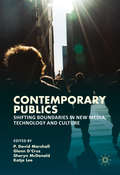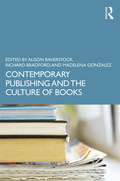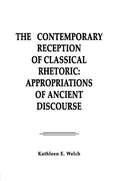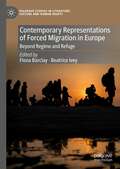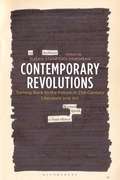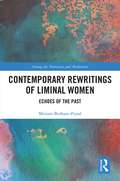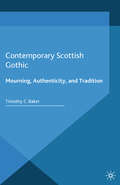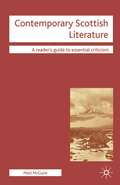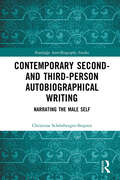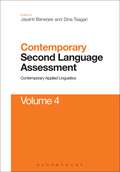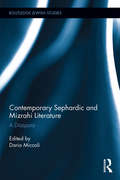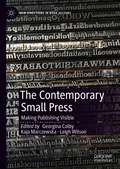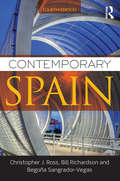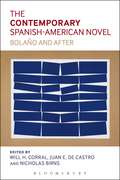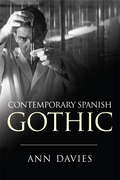- Table View
- List View
Contemporary Publics: Shifting Boundaries in New Media, Technology and Culture
by P. David Marshall Glenn D'Cruz Katja Lee Sharyn McDonaldIf the twentieth century has been dominated by discussions of the public, public life, and the public sphere, Contemporary Publics argues that, in the twenty-first century, we must complicate the singularity of that paradigm and start thinking of our world in terms of multiple, overlapping, and competing publics. In three distinct streams—art, media and technology, and the intimate life—this volume offers up the intellectual and political significance of thinking through the plurality of our publics. “Countering Neoliberal Publics: Screen and Space,” explores how different artistic practices articulate the challenges and desires of multiple publics. “Making and Shaping Publics: Discourse and Technology” showcases how media shape publics, and how new and emerging publics use these technologies to construct identities. “Commodifying Public Intimacies” examines what happens to the notion of the private when intimacies structure publics, move into public spaces, and develop value that can be exchanged and circulated.
Contemporary Publishing and the Culture of Books (Routledge Literature Companions)
by Alison BaverstockContemporary Publishing and the Culture of Books is a comprehensive resource that builds bridges between the traditional focus and methodologies of literary studies and the actualities of modern and contemporary literature, including the realities of professional writing, the conventions and practicalities of the publishing world, and its connections between literary publishing and other media. Focusing on the relationship between modern literature and the publishing industry, the volume enables students and academics to extend the text-based framework of modules on contemporary writing into detailed expositions of the culture and industry which bring these texts into existence; it brings economic considerations into line alongside creative issues, and examines how employing marketing strategies are utilized to promote and sell books. Sections cover: The standard university-course specifications of contemporary writing, offering an extensive picture of the social, economic, and cultural contexts of these literary genres The impact and status of non-literary writing, and how this compares with certain literary genres as an index to contemporary culture and a reflection of the state of the publishing industry The practicalities and conventions of the publishing industry Contextual aspects of literary culture and the book industry, visiting the broader spheres of publishing, promotion, bookselling, and literary culture Carefully linked chapters allow readers to tie key elements of the publishing industry to the particular demands and features of contemporary literary genres and writing, offering a detailed guide to the ways in which the three core areas of culture, economics, and pragmatics intersect in the world of publishing. Further to being a valuable resource for those studying English or Creative Writing, the volume is a key text for degrees in which Publishing is a component, and is relevant to those aspects of Media Studies that look at interactions between the media and literature/publishing.
Contemporary Publishing and the Culture of Books (Routledge Literature Companions)
by Alison Baverstock Richard Bradford Madalena GonzalezContemporary Publishing and the Culture of Books is a comprehensive resource that builds bridges between the traditional focus and methodologies of literary studies and the actualities of modern and contemporary literature, including the realities of professional writing, the conventions and practicalities of the publishing world, and its connections between literary publishing and other media. Focusing on the relationship between modern literature and the publishing industry, the volume enables students and academics to extend the text-based framework of modules on contemporary writing into detailed expositions of the culture and industry which bring these texts into existence; it brings economic considerations into line alongside creative issues, and examines how employing marketing strategies are utilized to promote and sell books. Sections cover: The standard university-course specifications of contemporary writing, offering an extensive picture of the social, economic, and cultural contexts of these literary genres The impact and status of non-literary writing, and how this compares with certain literary genres as an index to contemporary culture and a reflection of the state of the publishing industry The practicalities and conventions of the publishing industry Contextual aspects of literary culture and the book industry, visiting the broader spheres of publishing, promotion, bookselling, and literary culture Carefully linked chapters allow readers to tie key elements of the publishing industry to the particular demands and features of contemporary literary genres and writing, offering a detailed guide to the ways in which the three core areas of culture, economics, and pragmatics intersect in the world of publishing. Further to being a valuable resource for those studying English or Creative Writing, the volume is a key text for degrees in which Publishing is a component, and is relevant to those aspects of Media Studies that look at interactions between the media and literature/publishing.
The Contemporary Reception of Classical Rhetoric: Appropriations of Ancient Discourse (Routledge Communication Series)
by Kathleen E. WelchResponding to the reassertion of orality in the twentieth century in the form of electronic media such as the telegraph, film, video, computers, and television, this unique volume traces the roots of classical rhetoric in the modern world. Welch begins by changing the current view of classical rhetoric by reinterpreting the existing texts into fluid language contexts -- a change that requires relinquishing the formulaic tradition, acquiring an awareness of translation issues, and constructing a classical rhetoric beginning with the Fifth Century B.C. She continues with a discussion of the adaptability of this material to new language situations, including political, cultural, and linguistic change, providing it with much of its power as well as its longevity. The book concludes that classical rhetoric can readily address any situation since it focuses not only on critical stances toward discourse that already exists, but also presents elaborate theories for the production of new discourse.
The Contemporary Reception of Classical Rhetoric: Appropriations of Ancient Discourse (Routledge Communication Series)
by Kathleen E. WelchResponding to the reassertion of orality in the twentieth century in the form of electronic media such as the telegraph, film, video, computers, and television, this unique volume traces the roots of classical rhetoric in the modern world. Welch begins by changing the current view of classical rhetoric by reinterpreting the existing texts into fluid language contexts -- a change that requires relinquishing the formulaic tradition, acquiring an awareness of translation issues, and constructing a classical rhetoric beginning with the Fifth Century B.C. She continues with a discussion of the adaptability of this material to new language situations, including political, cultural, and linguistic change, providing it with much of its power as well as its longevity. The book concludes that classical rhetoric can readily address any situation since it focuses not only on critical stances toward discourse that already exists, but also presents elaborate theories for the production of new discourse.
Contemporary Representations of Forced Migration in Europe: Beyond Regime and Refuge (Palgrave Studies in Literature, Culture and Human Rights)
by Fiona Barclay Beatrice IveyThis book engages with current debates around refugeedom by examining cultural production that represents and interrogates the construction of refugees and the refugee experience on the borders of contemporary Europe. The refugee subject is produced by discursive regimes and border practices inherited from colonial projects that construct the diametrically opposed concepts of citizen and refugee, and their attendant administrative sub-categories. In the early twenty-first century these categories have been strengthened by the politicisation of forced migration and the hardening of ‘Fortress Europe’. While the predominant response to the increasing numbers of refugees seeking asylum in Europe has been to harden the borders (regime), on the one hand, or to stress the common humanity of those displaced (refuge), on the other, this volume argues that both approaches result in refugees becoming objectified, othered, and abstracted as vectors ofexile. It explores what recent cultural production can achieve in engaging with and representing issues of dispossession, detention and resettlement, and probes the limits of artistic potential to mediate the refugee experience. It examines transnational approaches to cultural production that both occupy and exceed the borders of Europe, with a focus on borderscapes, spaces of detention, and (neo-)colonialism. Bringing together original contributions from an international range of scholars, it analyses contemporary textual and visual representations of forced migration to argue that other forms of solidarity and hospitality towards refugees in Europe and beyond must be possible.
Contemporary Revolutions: Turning Back to the Future in 21st-Century Literature and Art
by Susan Stanford FriedmanReturning to revolution's original meaning of 'cycle', Contemporary Revolutions explores how 21st-century writers, artists, and performers re-engage the arts of the past to reimagine a present and future encompassing revolutionary commitments to justice and freedom. Dealing with histories of colonialism, slavery, genocide, civil war, and gender and class inequities, essays examine literature and arts of Africa, Europe, the Middle East, the Pacific Islands, and the United States. The broad range of contemporary writers and artists considered include fabric artist Ellen Bell; poets Selena Tusitala Marsh and Antje Krog; Syrian artists of the civil war and Sana Yazigi's creative memory web site about the war; street artist Bahia Shehab; theatre installation artist William Kentridge; and the recycles of Virginia Woolf by multi-media artist Kabe Wilson, novelist W. G. Sebald, and the contemporary trans movement.
Contemporary Revolutions: Turning Back to the Future in 21st-Century Literature and Art
by Susan Stanford FriedmanReturning to revolution's original meaning of 'cycle', Contemporary Revolutions explores how 21st-century writers, artists, and performers re-engage the arts of the past to reimagine a present and future encompassing revolutionary commitments to justice and freedom. Dealing with histories of colonialism, slavery, genocide, civil war, and gender and class inequities, essays examine literature and arts of Africa, Europe, the Middle East, the Pacific Islands, and the United States. The broad range of contemporary writers and artists considered include fabric artist Ellen Bell; poets Selena Tusitala Marsh and Antje Krog; Syrian artists of the civil war and Sana Yazigi's creative memory web site about the war; street artist Bahia Shehab; theatre installation artist William Kentridge; and the recycles of Virginia Woolf by multi-media artist Kabe Wilson, novelist W. G. Sebald, and the contemporary trans movement.
Contemporary Rewritings of Liminal Women: Echoes of the Past (Among the Victorians and Modernists)
by Miriam Borham-PuyalThis book explores the concept of liminality in the representation of women in eighteenth and nineteenth century literature, as well as in contemporary rewritings, such as novels, films, television shows, videogames, and graphic novels. In particular, the volume focuses on vampires, prostitutes, quixotes, and detectives as examples of new women who inhabit the margins of society and populate its narratives. Therefore, it places together for the first time four important liminal identities, while it explores a relevant corpus that comprises four centuries and several countries. Its diachronic, transnational, and comparative approach emphasizes the representation across time and space of female sexuality, gender violence, and women’s rights, also employing a liminal stance in its literary analysis: facing the past in order to understand the present. By underlining the dialogue between past and present this monograph contributes to contemporary debates on the representation of women and the construction of femininity as opposed to hegemonic masculinity, for it exposes the line of thought that has brought us to the present moment, hence, challenging assumed stereotypes and narratives. In addition, by using popular narratives and media, the present work highlights the value of literature, films, or alternative forms of storytelling to understand how women’s place in society, their voice, and their presence have been and are still negotiated in spaces of visibility, agency, and power.
Contemporary Rewritings of Liminal Women: Echoes of the Past (Among the Victorians and Modernists)
by Miriam Borham-PuyalThis book explores the concept of liminality in the representation of women in eighteenth and nineteenth century literature, as well as in contemporary rewritings, such as novels, films, television shows, videogames, and graphic novels. In particular, the volume focuses on vampires, prostitutes, quixotes, and detectives as examples of new women who inhabit the margins of society and populate its narratives. Therefore, it places together for the first time four important liminal identities, while it explores a relevant corpus that comprises four centuries and several countries. Its diachronic, transnational, and comparative approach emphasizes the representation across time and space of female sexuality, gender violence, and women’s rights, also employing a liminal stance in its literary analysis: facing the past in order to understand the present. By underlining the dialogue between past and present this monograph contributes to contemporary debates on the representation of women and the construction of femininity as opposed to hegemonic masculinity, for it exposes the line of thought that has brought us to the present moment, hence, challenging assumed stereotypes and narratives. In addition, by using popular narratives and media, the present work highlights the value of literature, films, or alternative forms of storytelling to understand how women’s place in society, their voice, and their presence have been and are still negotiated in spaces of visibility, agency, and power.
Contemporary Scottish Gothic: Mourning, Authenticity, and Tradition (Palgrave Gothic)
by T. BakerAn innovative reading of a wide range of contemporary Scottish novels in relation to literary tradition and modern philosophy, Contemporary Scottish Gothic provides a new approach to Scottish fiction and Gothic literature, and offers a fuller picture of contemporary Scottish Gothic than any previous text.
Contemporary Scottish Literature (Readers' Guides to Essential Criticism)
by Matt McGuireThis Guide examines the critical construction of the genre of 'contemporary Scottish literature' and assesses the critical responses to a wide range of contemporary Scottish fiction, poetry and drama. The Guide is structured thematically with each chapter addressing a specific area of debate within the field of contemporary Scottish Studies.
Contemporary Scottish Literature (Readers' Guides to Essential Criticism)
by Matt McGuireThis Guide examines the critical construction of the genre of 'contemporary Scottish literature' and assesses the critical responses to a wide range of contemporary Scottish fiction, poetry and drama. The Guide is structured thematically with each chapter addressing a specific area of debate within the field of contemporary Scottish Studies.
Contemporary Second- and Third-Person Autobiographical Writing: Narrating the Male Self (Routledge Auto/Biography Studies)
by Christina Schönberger-StepienThis book explores 21st-century uses of the second- and third-person perspective in Anglophone autobiographical narratives by canonical male writers. Through detailed readings of contemporary autobiographical works by Paul Auster, Julian Barnes, J.M. Coetzee, and Salman Rushdie, the study demonstrates the multiple aesthetic, rhetorical, and un/ethical implications of the choice of narrative perspective as well as the uncommon step of articulating the self from a perspective which is not I. Drawing on (rhetorical) narratology and autobiography theory, the book engages with questions and tensions of subjectivity and relationality, the interplay of distance and proximity resulting from the narrative perspective, and its effects on the relationship between autobiographer, text, and reader. In addition, the book traces relevant guiding principles that the authors use to navigate their self-narratives in relation to others, such as questions of embodiment, visuality, grief, ethics, and politics. Situating the narratives in their socio-political and cultural context, the book uncovers to what extent these autobiographical narratives reflect the authors’ position between self-withdrawal and self-promotion as well as their response to questions of male agency, self-stylisation, and celebrity status.
Contemporary Second- and Third-Person Autobiographical Writing: Narrating the Male Self (Routledge Auto/Biography Studies)
by Christina Schönberger-StepienThis book explores 21st-century uses of the second- and third-person perspective in Anglophone autobiographical narratives by canonical male writers. Through detailed readings of contemporary autobiographical works by Paul Auster, Julian Barnes, J.M. Coetzee, and Salman Rushdie, the study demonstrates the multiple aesthetic, rhetorical, and un/ethical implications of the choice of narrative perspective as well as the uncommon step of articulating the self from a perspective which is not I. Drawing on (rhetorical) narratology and autobiography theory, the book engages with questions and tensions of subjectivity and relationality, the interplay of distance and proximity resulting from the narrative perspective, and its effects on the relationship between autobiographer, text, and reader. In addition, the book traces relevant guiding principles that the authors use to navigate their self-narratives in relation to others, such as questions of embodiment, visuality, grief, ethics, and politics. Situating the narratives in their socio-political and cultural context, the book uncovers to what extent these autobiographical narratives reflect the authors’ position between self-withdrawal and self-promotion as well as their response to questions of male agency, self-stylisation, and celebrity status.
Contemporary Second Language Assessment: Contemporary Applied Linguistics Volume 4 (Contemporary Applied Linguistics)
by Jayanti Veronique Banerjee Dina TsagariIncludes chapters on key aspects of second language assessment such as test construct, diagnosis, exam design, and the growing range of public policy, social and ethical issues. Each of the contributors is an expert in their area; some are established names while others are talented newcomers to the field. The chapters present new research or perspectives on traditional concerns such as test quality; fairness and bias; the testing of different language skills; the needs of different groups of examinees, including English language learners who need to take content tests in English; and the use of language assessments for gate-keeping purposes. The volume demonstrates how language assessment is informed by and engages with neighbouring areas of applied linguistics such as technology and language corpora. The book represents the best of current practice in second language assessment and, as a one volume reference, will be invaluable to students and researchers looking for material that extends their understanding of the field.
Contemporary Second Language Assessment: Contemporary Applied Linguistics Volume 4 (Contemporary Applied Linguistics)
by Jayanti Veronique Banerjee Dina TsagariIncludes chapters on key aspects of second language assessment such as test construct, diagnosis, exam design, and the growing range of public policy, social and ethical issues. Each of the contributors is an expert in their area; some are established names while others are talented newcomers to the field. The chapters present new research or perspectives on traditional concerns such as test quality; fairness and bias; the testing of different language skills; the needs of different groups of examinees, including English language learners who need to take content tests in English; and the use of language assessments for gate-keeping purposes. The volume demonstrates how language assessment is informed by and engages with neighbouring areas of applied linguistics such as technology and language corpora. The book represents the best of current practice in second language assessment and, as a one volume reference, will be invaluable to students and researchers looking for material that extends their understanding of the field.
Contemporary Sephardic and Mizrahi Literature: A Diaspora (Routledge Jewish Studies Series)
by Dario MiccoliIn the last few years, the fields of Sephardic and Mizrahi Studies have grown significantly, thanks to new publications which take into consideration unexplored aspects of the history, literature and identity of modern Middle Eastern and North African Jews. However, few of these studies abandoned the Diaspora/Israel dichotomy and analysed the Jews who moved to Israel and those that settled elsewhere as part of a new, diverse and interconnected diaspora. Contemporary Sephardic and Mizrahi Literature argues that the literary texts produced by Sephardic and Mizrahi Jews who migrated from the Middle East and North Africa in the 1950s and afterwards, should be considered as part of a transnational arena, in which forms of Jewish diasporism and postcolonial displacement interweave. Through an original perspective that focuses on novelists, poets, professional and amateur writers – from the Israeli poets Erez Biton and Shva Salhoov to Francophone authors such as Chochana Boukhobza, Ami Bouganim and Serge Moati – the book explains that these Sephardic and Mizrahi authors are part of a global literary diaspora at the crossroads of past Arab legacies, new national identities and persistent feelings of Jewishness. Some of the chapters emphasise how the Sephardic and Mizrahi past and present identities are narrated, how generational and ethno-national issues are taken into account and which linguistic and stylistic strategies the authors adopted. Other chapters focus more explicitly on how the relations between national societies and different Jewish migrant communities are narrated, both in today’s Israel and in the diaspora. The book helps to bridge the gap between Hebrew and postcolonial literature, and opens up new perspectives on Sephardic and Mizrahi literature. It will be a valuable resource for students and scholars of Jewish and Postcolonial Studies and Comparative Literature
Contemporary Sephardic and Mizrahi Literature: A Diaspora (Routledge Jewish Studies Series)
by Dario MiccoliIn the last few years, the fields of Sephardic and Mizrahi Studies have grown significantly, thanks to new publications which take into consideration unexplored aspects of the history, literature and identity of modern Middle Eastern and North African Jews. However, few of these studies abandoned the Diaspora/Israel dichotomy and analysed the Jews who moved to Israel and those that settled elsewhere as part of a new, diverse and interconnected diaspora. Contemporary Sephardic and Mizrahi Literature argues that the literary texts produced by Sephardic and Mizrahi Jews who migrated from the Middle East and North Africa in the 1950s and afterwards, should be considered as part of a transnational arena, in which forms of Jewish diasporism and postcolonial displacement interweave. Through an original perspective that focuses on novelists, poets, professional and amateur writers – from the Israeli poets Erez Biton and Shva Salhoov to Francophone authors such as Chochana Boukhobza, Ami Bouganim and Serge Moati – the book explains that these Sephardic and Mizrahi authors are part of a global literary diaspora at the crossroads of past Arab legacies, new national identities and persistent feelings of Jewishness. Some of the chapters emphasise how the Sephardic and Mizrahi past and present identities are narrated, how generational and ethno-national issues are taken into account and which linguistic and stylistic strategies the authors adopted. Other chapters focus more explicitly on how the relations between national societies and different Jewish migrant communities are narrated, both in today’s Israel and in the diaspora. The book helps to bridge the gap between Hebrew and postcolonial literature, and opens up new perspectives on Sephardic and Mizrahi literature. It will be a valuable resource for students and scholars of Jewish and Postcolonial Studies and Comparative Literature
The Contemporary Small Press: Making Publishing Visible (New Directions in Book History)
by Georgina Colby Kaja Marczewska Leigh WilsonThe Contemporary Small Press: Making Publishing Visible addresses the contemporary literary small press in the US and UK from the perspective of a range of disciplines. Covering numerous aspects of small press publishing—poetry and fiction, children’s publishing, the importance of ethical commitments, the relation to the mainstream, the attitudes of those working for presses, the role of the state in supporting presses—scholars from literary criticism, the sociology of literature and publishing studies demonstrate how a variety of approaches and methods are needed to fully understand the contemporary small press and its significance for literary studies and for broader literary culture.
Contemporary Spain
by Bill Richardson Christopher Ross Begoña Sangrador-VegasContemporary Spain provides an accessible introduction to the politics, economy, institutions media and cinema of contemporary Spain. This fully revised fourth edition includes new material that makes this the most comprehensive, accurate and up-to-date account of the situation in Spain at this juncture Key features include: accessible and authoritative background information ideal for the non-specialist language student each chapter contains a Spanish/English glossary giving guidance on the use of specialist terms in context along with further reading ideal starting point for more in-depth study. New to this edition: coverage brought up-to-date to include the current economic crisis, related austerity measures and social difficulties new section on the changing public perception of the Spanish monarchy and significant new cases of corruption several chapters expanded to include key topics such as the role of the Internet and social media, key economic issues currently facing the country, youth employment and civil discontent ‘Spain in the Contemporary World’ thoroughly revised to include a more comprehensive account of the relationship between Spain and the EU and other parts of the world new chapter on ‘The Media and Film’ covering covering the most relevant directors and films in contemporary Spanish cinema.. This chapter also includes a discussion on the regional differences and cultures of the various autonomous communities. Suggestions for further reading at the end of each chapter. Contemporary Spain is an invaluable resource for all undergraduate students on Hispanic Studies courses. The authoritative background information provides a solid foundation and a springboard for further study.
Contemporary Spain: A Handbook (A\hodder Arnold Publication)
by Bill Richardson Christopher Ross Begoña Sangrador-VegasContemporary Spain provides an accessible introduction to the politics, economy, institutions media and cinema of contemporary Spain. This fully revised fourth edition includes new material that makes this the most comprehensive, accurate and up-to-date account of the situation in Spain at this juncture Key features include: accessible and authoritative background information ideal for the non-specialist language student each chapter contains a Spanish/English glossary giving guidance on the use of specialist terms in context along with further reading ideal starting point for more in-depth study. New to this edition: coverage brought up-to-date to include the current economic crisis, related austerity measures and social difficulties new section on the changing public perception of the Spanish monarchy and significant new cases of corruption several chapters expanded to include key topics such as the role of the Internet and social media, key economic issues currently facing the country, youth employment and civil discontent ‘Spain in the Contemporary World’ thoroughly revised to include a more comprehensive account of the relationship between Spain and the EU and other parts of the world new chapter on ‘The Media and Film’ covering covering the most relevant directors and films in contemporary Spanish cinema.. This chapter also includes a discussion on the regional differences and cultures of the various autonomous communities. Suggestions for further reading at the end of each chapter. Contemporary Spain is an invaluable resource for all undergraduate students on Hispanic Studies courses. The authoritative background information provides a solid foundation and a springboard for further study.
The Contemporary Spanish-American Novel: Bolano and After
by Will H. Corral Juan E. De Castro Nicholas BirnsThe Contemporary Spanish-American Novel provides an accessible introduction to an important World literature. While many of the authors covered-Aira, Bolaño, Castellanos Moya, Vásquez-are gaining an increasing readership in English and are frequently taught, there is sparse criticism in English beyond book reviews. This book provides the guidance necessary for a more sophisticated and contextualized understanding of these authors and their works. Underestimated or unfamiliar Spanish American novels and novelists are introduced through conceptually rigorous essays. Sections on each writer include:*the author's reception in their native country, Spanish America, and Spain*biographical history*a critical examination of their work, including key themes and conceptual concerns*translation history*scholarly receptionThe Contemporary Spanish-American Novel offers an authoritative guide to a rich and varied novelistic tradition. It covers all demographic areas, including United States Latino authors, in exploring the diversity of this literature and its major themes, such as exile, migration, and gender representation.
The Contemporary Spanish-American Novel: Bolano and After
by Will H. Corral Juan E. De Castro Nicholas BirnsThe Contemporary Spanish-American Novel provides an accessible introduction to an important World literature. While many of the authors covered-Aira, Bolaño, Castellanos Moya, Vásquez-are gaining an increasing readership in English and are frequently taught, there is sparse criticism in English beyond book reviews. This book provides the guidance necessary for a more sophisticated and contextualized understanding of these authors and their works. Underestimated or unfamiliar Spanish American novels and novelists are introduced through conceptually rigorous essays. Sections on each writer include:*the author's reception in their native country, Spanish America, and Spain*biographical history*a critical examination of their work, including key themes and conceptual concerns*translation history*scholarly receptionThe Contemporary Spanish-American Novel offers an authoritative guide to a rich and varied novelistic tradition. It covers all demographic areas, including United States Latino authors, in exploring the diversity of this literature and its major themes, such as exile, migration, and gender representation.
Contemporary Spanish Gothic
by Ann DaviesExamines Spain's contribution to international interest in Gothic culture, film and literatureWith the success of novels such as The Shadow of the Wind and films like The Others, contemporary Spanish culture has contributed a great deal to the imagery and experience of the Gothic, although such contributions are not always recognised as being specifically Spanish in origin. Contemporary Spanish Gothic is the first book to study how the Gothic mode intersects with cultural production in Spain today, considering some of the ways in which such production feeds off and simultaneously feeds into Gothic production more widely. Examining the works of writers and filmmakers like Carlos Ruiz Zafón, Arturo Pérez-Reverte, Pedro Almodóvar and Alejandro Amenábar, as well as the further reaches of Spanish Gothic influence in the Twilight film series, the book considers images and themes like the mad surgeon and the vulnerable body, the role of the haunted house, and the heritage biopics of Francisco de Goya.
